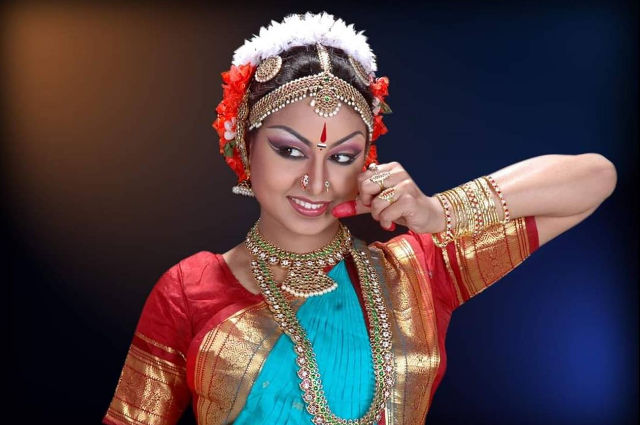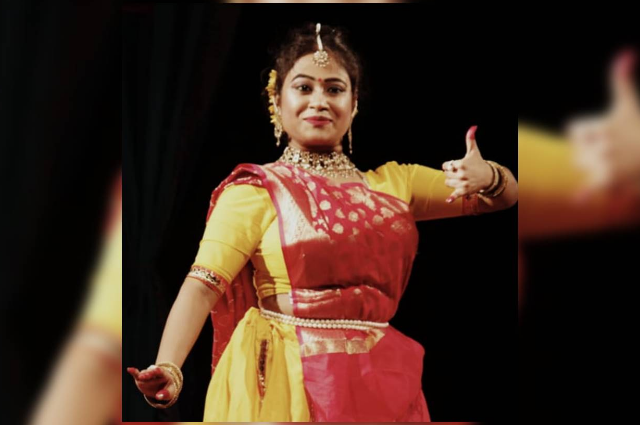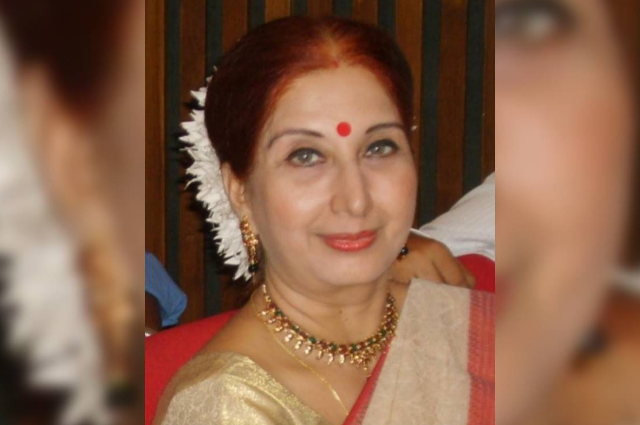
Professor Amita Dutt is one of the leading exponents of Kathak in India. She has been the Uday Shankar Professor of Dance Founder Director, of the Performing Arts Therapy Centre, and Dean of the Faculty of Fine Arts (2006-2010) at the prestigious Rabindra Bharati University (RBU) in Kolkata. She has performed far and wide across three continents and given innumerable dance recitals in prestigious dance and music festivals including the Festival of India and other official government functions before the Prime Minister of Japan and the President of India. Furthermore, Professor Dutt has been experimenting with different new choreographic patterns blending pure Kathak movements with popular songs and innovative themes. She is the Founder and Director of the Performing Arts Therapy Centre at Rabindra Bharati University where serious research is conducted and training is given to serve the ailing and the impaired through dance, drama, and music.

A gold medalist in English from the famous Calcutta University, Professor Amita Dutt has a wide range of research publications on various aspects of dance. She has contributed to several cultural encyclopedias and has also a series of CDs on dance training produced by the UGC Consortium for Education Communication. A dedicated teacher, Professor Amita Dutt’s students include National and State Champions and Scholarship Awardees, top performers, and University Gold Medallists to mention only a handful of our illustrious career in dancing. She was invited by the Government of the United States to the prestigious American Dance Festival where she performed, and taught in Master Classes. She was also invited by the Government of China to give performances at the China Kunming International Culture and Tourism Festival.
It is important to mention that Innumerable awards and honors have been conferred on her. She has been honored at the North American Bengali Conference and the Mayor of Cincinnati, USA gave her the Keys to the City thereby making her an Honorary Citizen and also called that day, May 15, 1994, Amita Dutt Day. In November 2004 she received the Governor’s Commendation in recognition of her contribution to Art from Brad Henry, Governor of the State of Oklahoma, USA. On May 26, 2014, she was conferred the Uday Shankar Award – Lifetime Achievement Award for Dance - by the Government of West Bengal. On December 2015 she was honored with Lifetime Achievement Award by the Doordarshan. On Teachers Day, (September 5, 2017), she was awarded the Shiksha Ratna Sanman by the Government of West Bengal, Department of Education. In 2018 she was honoured by the Public Relations Society of India, (Kolkata Chapter) on the occasion of their Diamond Jubilee.
Her Online teaching has been in progress through the Massive Open Online Courses titled Foundation Course in Kathak (June to December 2020, July to December 2021) and Junior Course in Kathak (January to June 2021) hosted on MHRD's SWAYAM portal with EMMRC, St. Xavier's College as the Regional Nodal Agency.
These courses are supported by the Consortium for Education Communication (CEC) and the University Grants Commission (UGC). More than 5,000 students have registered for these courses. Her teachings are also available on YouTube. Scholar, choreographer, danseuse, researcher, professor, and social worker Amita’s main aim is to popularize her dance style all across the globe. She is working hard to establish the Kolkata Gharana of Kathak which will feature Bengal’s distinctive contribution to this art form. Professor Amita Dutt has always endeavored to reach out to a wide section of the audience, thereby making her classical dance form appeal to the masses. She has also given innumerable performances for social service causes.

Professor Amita Dutt was honored by the Alumni Association of the Dance Department, Rabindra Bharati University on the auspicious World Dance Day (April 29th). She along with other members of the dance fraternity was felicitated on the stage of the auditorium of the prestigious Star Theatre for her monumental contributions to dance teaching and research over the past five decades. Prof Dutta commented, “ …..At one time hailed as the Mother of all Art forms, the art of dance has seen ups and downs over centuries. Its aesthetic and therapeutic qualities have been praised and again in some communities, it has been looked down on as the human body is the medium of this art form. The International Dance Council (CID) has been working incessantly to establish the importance of dance in our lives.”
She further emphasized that ….” To dedicate a special day for the celebration of the curative and communicative powers of dance CID chose the birth anniversary of Jean-Georges Noverre, the Father of Modern ballet, who was born on April 29, 1727. The CID encourages us to perform, participate and enjoy dance by taking part, watching, and discussing dance. Let us all spread the awareness of dance and celebrate this day with pomp and grandeur.” The RBU authority staged a gala evening cultural program that was greatly appreciated by the audience in the packed Star Theatre auditorium. On April 30, Dr. Dutt again participated via webinar at the national level World Dance Day at the AYUSH SAMRIDHI celebration organized by the Independent Research Ethics Society. Prof Dutt again enlightened the captivated online audience by presenting dance as an integral part of human society and culture. She beautifully explained the various Indian classical dance firms and highlighted on their origins, styles, geographical distribution, and current status.
Next on the same online platform, Prof Dutt’s ex PhD student, Dr. Anuradha made her presentation that was beautifully received by the audience. Dr. Anuradha Roy is a highly distinguished national and international classical dancer. She is a Doordarshan "A" Grade dance performer, a National Scholarship Awardee in Classical Dance, the serving Principal of Sri Hamsavahini Kalalayam, and the Founder of Sri Podabalio Kala Parishad. Dr. Roy is an acclaimed academic, holding a double MA and a Ph.D. in Neurocognitive Dance Therapy.
She is a National Gold Medalist and a National Awardee; and performed at different national and overseas dance festivals and cultural exchange programs in Singapore, Vietnam, China, the Maldives, and Bangladesh (organized by ICCR, Govt of India). Dr. Anuradha Roy has performed as a dancer and also served as a leading choreographer on several national TV channels like Zee TV, Star TV, and other popular channels. She is an avid speaker on classical dance, dance therapy, and related cultural issues.
Dr. Roy highlighted on the implications of different mudras used in dancing and their impact on our life. She is connected to both social health and human development. She said, ….” Lack of discipline, devotion, and hard work among new dance aspirations is an obstacle to becoming a classical dancer. …..It needs devotion, tenacity, and sincerity to transform or blossom into a fully open flower from an unfolded seed. “ She highlighted that traditional healing through dance is also quite good and easy to afford. Our ancient dance forms have prescribed different mudras for exercise to heal various deformities and ailments, so dance is an integral part of our life. Not simply as a cultural heritage but also as a support system for a healthy body-mind.
Lastly, Miss Shramana Chattopadhyay has been learning kathak under Guru Prof. Amita Dutt for the past 13 years; and also took lessons from Shri Sandip Mallick and participated in this international webinar along with her Guru, Orofessir Dutt. She has participated in different workshops conducted by Pdt. Birju Maharaj ji, Prof. Amita Dutt, Shri Sandip Mallick and Ms. Alokparna Guha. She is also the distinguished CCRT Junior Scholarship Holder (2013). Shramana has performed with her guru Prof. Amita Dutt in different shows such as Uday Sankar Festival, and Mahanadi Festival and also in major cultural programs across India in Kolkata, New Delhi, Hyderabad, Lucknow, Bhopal etc. As a solo performer, she also performed in different prestigious shows like- KATHAK MARATHON, KATHAK YOUTH FESTIVAL, KOLKATA, and INTERNATIONAL DANCE FESTIVAL to mention only a handful. She is an upcoming Kathak sensation and distinguished position holder at the state, national, and international level competitions like 1st position in the 82nd Online All India Music Competition (2022), 2nd position in the competition organized by the West Bengal State Academy (2022), 2nd position in the International Kathak Contest (2021), etc.
Shramana Chattopadhyay, commented @…..that as a kathak learner and performer from Kolkata….Talking about the dance is like talking about the source of my life's energy, emotions, experiences, etc. Dance is a way of telling or better to say that it is a way of presenting different stories in front of audiences. Even the dancer can express their emotions also through their dancing. It helps to heal our pain, stress, anxiety, and tension & fills us with hope & positivity. Being a classical dancer I must say that classical dance is one of the biggest parts of the history of this country, culture & heritage. Definitely, the question comes: how? Actually, each and every classical dance style of India carries its own history which maybe looks like same in nature but still, they are different. If we notice we can see how the different classical dance styles are influenced by their particular area or place of origin, patronage, etc. For example, if we say about kathak- then we can see that it mainly originated in North India so we can find the similarity of the costume of Kathak (In Hindu style) with the North Indian dresses like Ghagra, Dupatta, etc. Then in Odissi, the dancers wear the silver jewelry because in Odissa silver is always considered as a pure offering. So the Odissi dancers wear silver jewelry. Then in south India, It is believed that white is the very pure color so in Mohiniyattam we can see that the dancers wear only white costumes.”. Shramana further elaborated, saying “……… In fact, through dance, we can present many historical or mythological stories of a particular area in front of the audience like- Manasamangal Kabya ( Bengal), the Story of Savitri Satyaban (Bengal), Stuti of Jagannatha (Odissa ) etc. So thus one can easily come to know about the history of our country. Watching a story in live with rhythms, moves, expressions, and instruments, one can easily understand the importance of that. So yes definitely these classical dance styles carry out the heritage & culture of this country.”
According to her, Indian culture, classical dance styles and even India itself is the example of unity in diversity. There have lot of variety but still, these all are showing one and only identity that is we are the Indians. Maybe the kathak mainly originated in India or Odissi in Odissa or Bharatnatyam in South India or Manipuri in Manipur but these are not from outside of India. These dances present the different beauty of this country. Sometimes it is all about soft moves & slow rhythm, sometimes it becomes very energetic, sometimes it is all about posture, and at other times it is all about telling stories. Actually, these dance styles refer to none other than the line "Unity in Diversity".
Shramana emphasized that, ….”To me, Dance is a way to connect myself with the entire universe. When there is no one to hold my hand, only dance stays there……Through dance I can express my feelings even when I am not able to cry out I do practice dance to make myself calm. Dance is a puja. I dance because I love to dance, I love to feel the peace while doing or practicing the dance. In fact, I would definitely like to say that in the pandemic situation when we had to be stuck in our house, my dance gave me the strength to fight against my negative thought and anxiety of mine. ……….I can't imagine my life without dance. So I really want to complete my further study on dance & also want to do research. With that, it is my dream to establish myself as a Kathak dancer. Classical dance is just like a "Sadhna" which you have to do for your whole life with the same passion.”
Dance is a form of self-expression. From the dawn of human civilization, dance has been an integral part of human society, and culture, invidious corners of the planet. Every society and civilization that is represented in various biogeographical regions of this world has its unique dance forms. Thus one can conclude that dance is a historical art form that has enriched our life by learning from the daily experiences and incidents that have happened in around us from time immemorial. One form of Don’s has originated from another and given rise to new sequence forms and patterns over time. India, being representative of a very rich ancient culture, has several major dance forms that are globally recognized, learned and celebrated including Kathak, Manipuri, Sattriya, Odishi, Kuchipudi, Bharat Natyam, Mohini Attam, and Kathakali. Bharatnatyam dance is almost 2,000 years old. It is believed that Bharatnatyam was revealed by Lord Brahma to Bharata, a famous sage who then codified this sacred dance in a Sanskrit text called the Natya Shastra. The Natya Shastra is one of the fundamental treatises on Indian drama and aesthetics.
Indian dance forms recognize 8-9 emotional states of mind, namely: Shringara (love/beauty), Hasya (laughter), Karuna (sorrow), Raudra (anger), Veera (heroism/courage), Bhayanaka (terror/fear), Bibhatsa (disgust), Adbutha (surprise/wonder), Shantha (peace or tranquility). The concept of the 9th Rasa was a later interpolation by the Kashmiri Shaivist Abhinavagupta (10th Century AD) and also his predecessor Anandavardhana (9th Century AD). Abhinavagupta extends the eight Rasas by adding the concept of the Santa Rasa which he regards as the essence of all Rasas. India embraces the world within her and this is an integral part of the International dance fraternity. The World Dance Day Dance Day is observed on 29th April every year. Initiated by the International Dance Council (IDC) in 1982, this global event aims to bridge cultures, connect people and promote the art of dance and its transformative power to express emotions. The concept of International Dance Day was proposed by the International Dance Council to commemorate the birth of Jean-Georges Noverre, the French dancer and choreographer who is considered the father of modern ballet. Noverre was born on April 29, 1727, and is best known for his treatise “Letters on Dancing and Ballet,” which laid the revolutionary foundation for modern ballet and dance as an art form. International Dance Day is being celebrated on 29th April this year like every year. It has been used for ritual, social and artistic purposes throughout history and across cultures. Dance can tell stories, express emotions and express ideas in ways that transcend language and cultural barriers.
